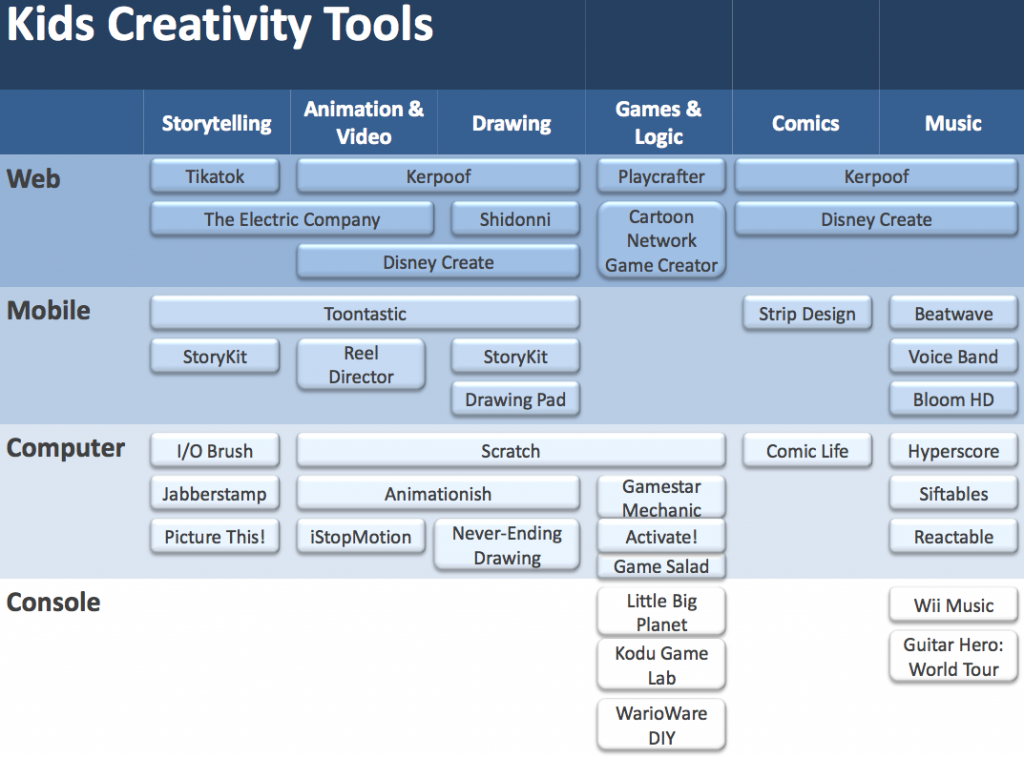In our last post we described how theories of creativity and learning should be integrated with creative problem solving approaches to address our nation’s creativity crisis. Recent advances in technology are enabling creators of children’s digital media to design more experiences that foster children’s creativity and learning. Although children’s digital media producers are beginning to create products for children that are marketed as creative tools, there is still a lack of mechanisms that have fully captured the type of open-ended, imaginative play that is proven to foster the roots of creativity in children.
Barriers to Digital Creativity Tools
Technological, marketing, and distribution barriers still remain in creating high-quality creative tools for kids on digital platforms. Although huge strides have been made in computer science and human-computer interaction, computers still struggle with complex, unpredictable human behaviors such as improvisation or conversation. Hayes Raffle, Principal Researcher at Nokia Research Labs and designer of open-ended toys ZOOB! and Topobo, says “Most digital tools today are like puzzles rather than like paint brushes – children can discover what designers have hidden inside them, and every child makes the same discoveries. With a paint brush, every child learns how to paint, but each makes something different, and those paintings each mean something personal to the children who made them.”
Not only is there an educational need, but also a hunger for higher-quality creativity tools. In a small study conducted by Latitude Research, 126 children aged 12 and under were asked to suggest concepts for new computer and Web technologies. Thirty one percent of technology ideas proposed by children were a tool or platform for creating something (a Web site, a game, a video to be shared, a physical object, etc.) Participants aspired to be 3D game designers, Web designers, fashion designers, industrial designers, musicians, and traditional artists. The study also found that “kids’ drive to use technology to create was highly under-acknowledged by parents.” Only 7% of participants’ parents chose some form of creation or design as an option as their child’s favorite computer activity while 70% selected gaming. In contrast participants’ artistic design related ideas ranked a close second to gaming ideas.
Kids Creativity Tools in the Marketplace
A growing number of children’s digital media aspires to offer kids creative opportunities. A chart of children’s digital creativity tools is available here with respect to platform and type of activity.
The list includes:
Programming Languages & Game Design:
• MIT Media Lab’s Scratch
• Google’s App Inventor for Android (not developed for kids, but based on Scratch)
• Microsoft’s Kodu Game Lab
• Sony’s LittleBigPlanet
• Electronic Art’s Create
• LEGO Universe
Arts and Crafts
• MIT’s Never-Ending Drawing Machine
• MIT Tangible Media Group’s I/O Brush
• Alison Lewis’ work in Switch Craft
Literacy & Storytelling
• The Electric Company video mashup tool
• Disney Create, powered by Kerpoof
• Jabberstamp
• International Children’s Digital Library’s StoryKit app for iPhone
• Cooney Center Prizes finalist, Launchpad Toys’ Toontastic for the iPad (Fall launch)
A great deal more research must be conducted around creative skills and the activities that support them. These commercial and academic creative tools for kids point to a promising future for these types of applications. However, given the great educational and market gaps, many opportunities still exist for producers to make tools that balance scaffolding with open-ended and imaginative play, as well as promote communication between kid designers and the caring adults in their lives. The Cooney Center’s report on Intergenerational Play & Literacy Learning offers some insights on how children’s media makers might intentionally produce play experiences that support this interaction.
A definition of “creative skills” that is compatible with America’s educational testing culture remains elusive. However, theories on creativity and learning, as well as effective practices from design thinking and systems thinking, must be part of the dialogue if we are raise our national CQ. By tapping into children’s passion for digital media with technology supported creative tools, we’ll offer them more opportunities to exercise their creative and design skills today so that they’ll be prepared to devise innovative solutions for the complex challenges of tomorrow.
Other blogs in this series:
Transforming Children’s Learning to Address America’s Creativity Crisis
Learning Across Silos: An Integrated Approach to the Creativity Crisis
Ann My Thai is the Assistant Director of the Joan Ganz Cooney Center at Sesame Workshop. She is also the lead author of the Center’s report on digital games and children’s health and learning, Game Changer. Andy Russell is an educational media designer with a special interest in developing toys and tools that empower kids to express themselves creatively through play. Andy is a Co-Founder of Launchpad Toys and has worked for companies like Hasbro and Sony PlayStation to design playful learning experiences for kids.





